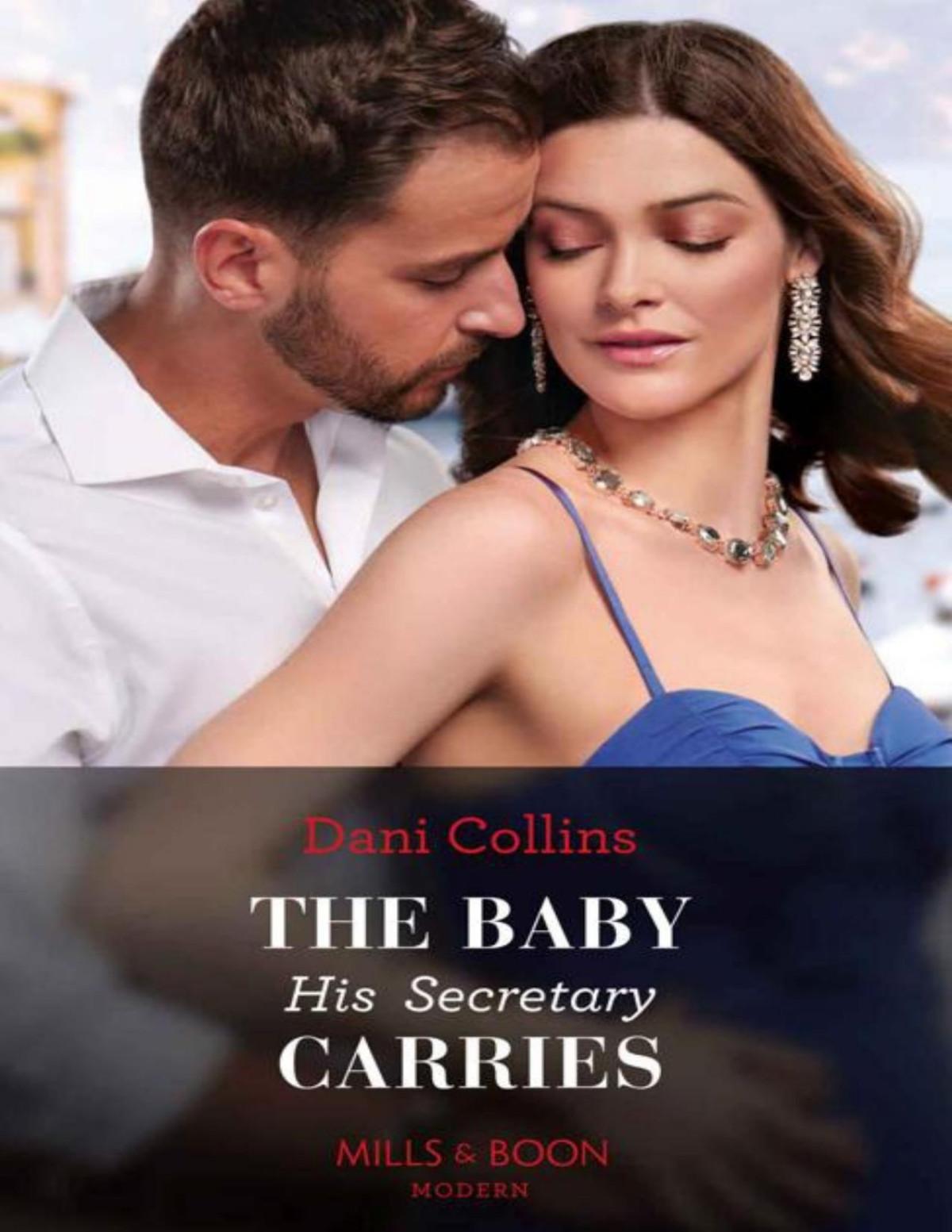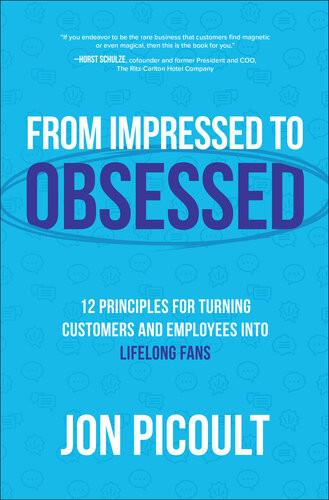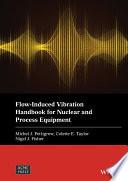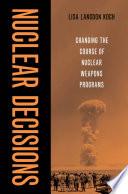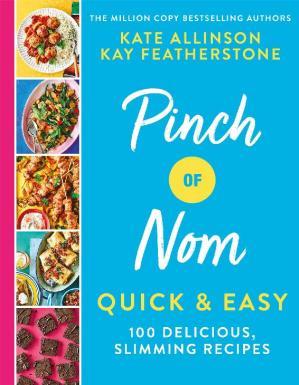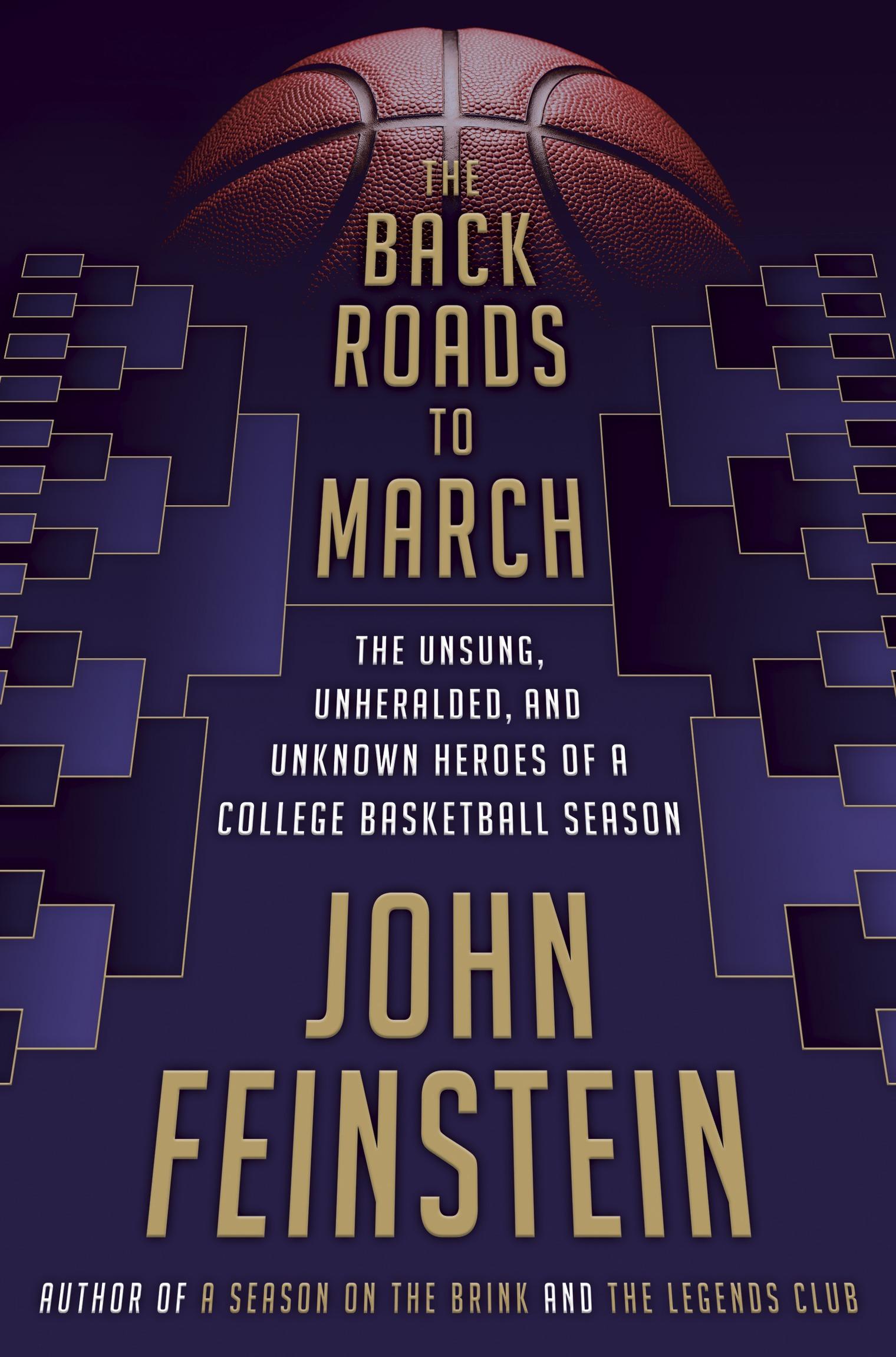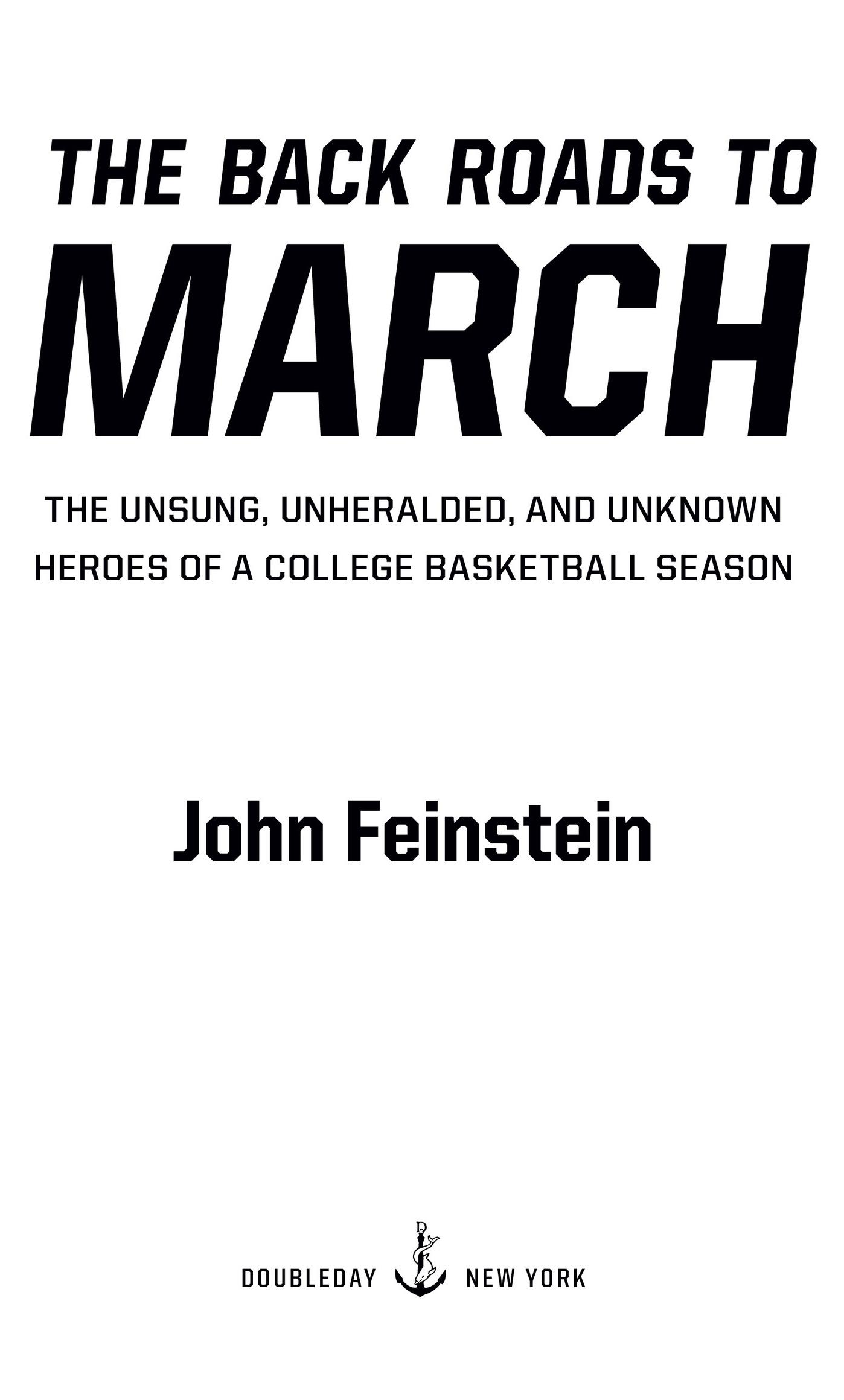Hard Courts Forever’s Team
A Season Inside A Season on the Brink
Copyright © 2020 by John Feinstein
All rights reserved. Published in the United States by Doubleday, a division of Penguin Random House LLC, New York, and distributed in Canada by Penguin Random House Canada Limited, Toronto.
www.doubleday.com
DOUBLEDAY and the portrayal of an anchor with a dolphin are registered trademarks of Penguin Random House LLC.
Cover illustration of basketball by KaiMook Studio 99 / Shutterstock
Cover design by Michael J. Windsor
Library of Congress Cataloging-in-Publication Data
Names: Feinstein, John, author
Title: The back roads to March : the unsung, unheralded, and unknown heroes of a college basketball season / by John Feinstein.
Description: First edition. | New York : Doubleday, [2020] | Includes index.
Identifiers: LCCN 2019047926 (print) | LCCN 2019047927 (ebook) | ISBN 9780385544481 (hardcover) | ISBN 9780385544498 (ebook)
Subjects: LCSH: NCAA Basketball Tournament. | Basketball teams—United States—History—21st century. | College sports—United States—History—21st century.
Classification: LCC GV885.49.N37 F43 2020 (print) | LCC GV885.49.N37 (ebook) | DDC 796.323/640973—dc23
LC record available at https://lccn.loc.gov/2019047926
LC ebook record available at https://lccn.loc.gov/2019047927
Ebook ISBN 9780385544498
v5.4 ep
This is for Jack Scheuer and Dick (Hoops) Weiss…Mentors. Friends. Companions. I cherish every minute we spend together—especially in the Palestra.
To win the game is great…
To play the game is greater…
But to love the game is the greatest of all.
CONTENTS
Cover
Also by John Feinstein
Title Page
Copyright Dedication
Epigraph
Introduction: Why the Back Roads
1. A New Beginning…and the Beginning of the End
2. And the Cadets Came Marching In
3. Breakfast and Basketball
4. From 0-135 to 1-135…and Beyond
5. The Rearview Mirror
6. Safety School
7. The Rock and a Very Hard Place
8. Last Fran Standing
9. I Own a College—Iona Is Iona
10. Living on the Edge
11. Day—and Night—in the Cathedral
12. Rock-and-Roll Heaven
13. Christmas Gifts and Christmas Coal
14. Second-Year Law Student
15. Philly Kid
16. Gray Days
17. Let’s Play Two!
18. More Than a Game
19. Yes, Christine, There Is a Farmville
20. From Kirby to the Palestra—Another Day in Hoops Heaven
21. The Old Coach and Division 3
22. Where History Was—and Is—Made
23. The Countdown Begins
24. Dog Days and Very Cold Nights
25. From High School to Hollywood…or Buffalo
26. The Hall of Famer They Missed
27. Starting from Square Zero
28. One Crucible for All
29. Tales of JJ and the Lefthander
30. In the Land of the Camels
31. The Madness Comes Quickly
32. Thanks for the Memories
33. The Road to Dayton…Leads Through Norfolk
34. And Then There Were Sixty-Eight: Selection Sunday
35. Back to the Beginning
36. Midnight for Cinderella…and for Me Epilogue
Acknowledgments
Illustrations About the Author
A
s soon as the buzzer sounded, I closed my computer. Ever helpful, the NCAA had put out its one millionth printed statement of Final Four weekend prior to the start of the game, warning all of us in the media that confetti would come pouring out of U.S. Bank Stadium’s ceiling as soon as the national championship game ended.
Sure enough here it came, and I quickly closed the computer so as not to have to spend several minutes picking confetti from the keys. Not my first rodeo. It was 10:40 central time in Minneapolis—11:40 in the east—and, as was always the case on Monday night, time was precious.
For a moment, while waiting to be able to safely open the computer and resume writing, I flashed back nine years to another Monday night. There were thirty-one seconds left in the NCAA championship game between Duke and Butler, and the Bulldogs had the ball and had just called a timeout, trailing 60–59.
Ohio State athletic director Gene Smith, who was that year’s chairman of the NCAA basketball committee, was sitting to my left. As the buzzer sounded to end the time-out, Smith leaned over to me and said, “Okay, you’re the ultimate defender of the little guy. But you’re also a Duke graduate. What do you want to see happen here?”
I looked at my watch. It was 11:37 p.m. in Indianapolis. Prior to the game, my editor at the Washington Post had told me that if I wanted my
column to make the home edition of the newspaper, he needed it in the office by midnight.
I had spent most of the last thirty minutes writing and rewriting as the game swung back and forth. The first ten paragraphs were unwritten, pending the outcome.
“Gene, it’s 11:37 p.m.,” I said. “I have to hit the send button by midnight or my column won’t make most of the morning’s papers. The only thing I don’t want to see is f—— overtime.”
Smith laughed. I could not have been more serious. The late, great Dave Anderson, the Pulitzer Prize–winning New York Times columnist, had explained to me early in my career that “the first rule of sportswriting is simple: it’s always okay to root for yourself.”
On that crisp April evening in 2010, I wasn’t rooting for Butler—the David of college basketball—a team that had pulled one upset after another to reach the final game and now had close to seventy thousand fans screaming for one last shocker to finish the Disney movie.
I wasn’t rooting for Duke—my alma mater—coached by Mike Krzyzewski, someone I had known well, liked, and admired for more than thirty years. In the minds of most college basketball fans, Duke wasn’t just Goliath; it was Darth Vader. The evil empire in shorts.
I wasn’t rooting for either team. I was rooting, at that moment, for me. I knew I had a great story—regardless of the outcome. I just needed to have time to write it so that the Post’s readers would get a chance to read it.
Nine years later, I had felt much the same way as the Virginia–Texas Tech national championship game wound down. Like Duke-Butler, it was riveting, the teams taking turns appearing to gain control.
Virginia had led by ten late in the second half, but Texas Tech had rallied to take a 68–65 lead with under twenty seconds to play. Somehow, the Red Raiders, a superb defensive team, lost track of UVA’s De’Andre Hunter, leaving him wide-open in the corner.
As soon as I saw Hunter catch the ball, I knew his three-point shot was going in and the game was going to overtime. Texas Tech lost in overtime; I lost in regulation.
But even as the clock ticked toward midnight on the East Coast and I waited impatiently for it to be safe to reopen my laptop, I was smiling while Virginia celebrated.
I was happy for Coach Tony Bennett, who had been brutally maligned a year earlier after the Cavaliers had become the first No. 1 seed in NCAA Tournament history to lose to a No. 16 seed. Prior to UVA’s game in Charlotte against the University of Maryland–Baltimore County, No. 1 seeds had been 135-0 against No. 16 seeds.
Just before midnight on the eve of St. Patrick’s Day, that record had become 135-1. UMBC-74, Virginia-54. That score hangs from a banner inside UMBC’s Retriever Events Center and will be there for as long as they continue to play basketball.
That loss hung around Bennett’s neck for more than a year. He answered every question, never snapped when it came up, and didn’t bother to mention that Hunter, arguably his best player, had been injured that night and watched the game from the bench.
Bennett never fell back on the clichés of jock-world losers: “That’s in the past, we’ve moved on”; “I only want to talk about the present”; or the catchall “That was a different team. I’m focused on this team.”
In a twist, the coach who most wanted to put UMBC-74, Virginia-54, behind him was UMBC coach Ryan Odom. His slogan for his 2018–19 team was “no looking in the rearview mirror.”
Odom’s Retrievers were a different team: K. J. Maura and Jairus Lyles, the senior guards who had keyed the upset, were both gone. UMBC wasn’t just a different team; it had a different place in the college basketball pantheon. No longer did basketball people wonder what the letters UMBC meant when spelled out.
Everyone knew what they meant: UMBC-74, Virginia-54. Or, if you preferred, 1-135.
“It’s an amazing story, isn’t it?” Bennett said to me about an hour after the nets came down in Minneapolis, referencing where his team had been
that night in Charlotte and where it was now, walking away with the championship plaque.
Of course, the NCAA had carefully choreographed every moment of the postgame celebration. First the confetti; then the players and coaches being herded onto a platform where NCAA president Mark Emmert would grab the microphone for a few unneeded words; followed by basketball committee chairman Bernard Muir, the athletic director at Stanford, presenting the plaque to Bennett.
Then the nets were cut down, not like in the old days when players hoisted one another and then the coaches up to the rim to get their cuts of the net, but on something called “the official ladder of the NCAA.”
Finally came the playing of the impossibly hokey and corny “One Shining Moment,” during which the players and coaches were required to stand on the podium looking teary-eyed and the media was required to clear the area around the podium.
Nothing interferes with “One Shining Moment.” It is, after all, a tribute to the purity of the great moments that make up the NCAA Tournament. Forget the FBI corruption investigations, the coaches with multimilliondollar salaries; this is all about the “student-athletes.”
Virginia was a worthy and eminently likable champion. And, within three weeks of the playing of “One Shining Moment,” four of their starters —all underclassmen—had declared for the NBA draft.
From “One Shining Moment” to “Show Me the Money.”
I didn’t blame any of them even a little bit.
As I watched the Virginia players cut down that final net, my mind raced sixty-one miles down the road from Charlottesville, Virginia, to Farmville, Virginia.
Yes, Farmville, Virginia, is a real place—although my wife was very skeptical about that fact on the night of January 24, 2019, when I had traveled there to watch Longwood University host High Point in a Big South Conference game.
“Classic coaching matchup,” Longwood coach Griff Aldrich had said that afternoon. “Me, with twelve career coaching wins, taking on Tubby Smith with six hundred and six—and a national championship.”
Griff smiled. “My players better be a lot better than his players, because I’m sure as heck not going to outcoach him.”
Aldrich’s players were good enough that night for a 55–51 victory, cutting the gap between Aldrich and Smith in wins from 594 to 593.
During the game, my wife, Christine, sent me a text. Christine is not exactly a jock. She got her undergraduate degree from Vassar in English literature. She then got a master’s from Boston University in English and Irish poetry and worked for five years for Robert Pinsky when he was the U.S. poet laureate. She was later a literary agent and an editor at Random House. She could undoubtedly have written a poem—or perhaps a sonnet— about the matchup between Aldrich and Smith. But she had no idea who they were, where they coached, or why I might be watching their teams play on a cold night in January.
Her in-game text was short and to the point: “I forget where you are tonight,” it said. “What time will you be home?”
“I’m in Farmville, Virginia,” I wrote back. “Home about midnight.”
The response came flying back almost as soon as I’d hit the send button: “You are having an affair,” it said. “There is no such place as Farmville, Virginia.”
Yes, Christine, there is a Farmville. And there is no question that Willett Hall, with 1,481 in attendance, was the place to be that night in Farmville.
The real question, then, was this: Why was I in a not-mythical place called Farmville that night?
The answer to the question really goes back to the night of the national championship game. My first Final Four was in 1978, in what was then called the St. Louis Checkerdome. The first game on semifinal Saturday, between Duke and Notre Dame, began at 12:30 central time. The second game—Kentucky and Arkansas—started just before 3 p.m. local time.
I was the night police reporter for the Washington Post, but had convinced sports editor George Solomon to let me fly out there since Duke was playing. I had graduated from Duke the previous May. In my four years
as an undergraduate, Duke finished last, tied for last, last, and tied for last in the ACC. In those days, when we talked about making the Final Four it was a reference to the semifinals of the ACC Tournament. It never happened while I was in school; the Blue Devils lost their opening game in the conference tournament every March.
Which is why the notion of being in the real Final Four seemed impossible. My deal with George was—as I would learn in later years— classic George. I paid my own way to St. Louis, shared a hotel room with columnist Ken Denlinger, and wrote a sidebar each day.
All George had to do was come up with a credential for me—sort of. He had sent one of the paper’s columnists, Dave Kindred, to cover the women’s Final Four, since the Maryland women were playing there. I had Kindred’s credential for Saturday’s semifinals. For the championship game Monday night, I was on my own.
This was years before media credentials had photos on them or there were security checks to get into a basketball game. After Duke beat Notre Dame on Saturday, Duke sports information director Tom Mickle found Skeeter Francis, the ACC’s media director.
“Need a credential for John for Monday,” Mickle said.
Skeeter reached into the pocket of his blindingly loud jacket, pulled out a credential, and handed it to me. Simple as that. On Saturday, I sat in Kindred’s courtside seat. On Monday night I sat in the seat assigned to the Notre Dame SID. He had gone home.
Those were the days.
They are, of course, long gone. The Final Four hasn’t been played in a basketball arena since 1996. Now it’s played in seventy-thousand-plus-seat football stadiums, with the court smack in the middle of the football field in order to maximize the number of seats that can be sold.
The benches are below floor level, as are the media seats, and most of the sight lines—even if you aren’t sitting upstairs five miles from courtside —aren’t very good.
But the Final Four sells out every year and has become one of those mega TV events that are part of the culture, like the Super Bowl, the World Series, and the Masters. People just want to say they were there.
Corporations pay big bucks to gain all the perks that come with being NCAA “corporate champions.”
I still go because I’m fortunate enough that the Washington Post still wants me to go—at least nowadays, unlike 1978, the paper pays my way— and because I enjoy seeing friends I’ve made in both media and coaching through the years. The Final Four is an annual convention of the college basketball world as much as it is a basketball tournament.
But it is no longer the joyride for me that it was in those innocent years when Skeeter Francis could pull a credential out of his pocket and hand it to me.
The first game on Saturday no longer starts at 1:30 eastern time; it starts at 6:10. In 1978, there were six scheduled TV time-outs per game that lasted ninety seconds each. Now there are ten, each lasting three minutes. Halftime, once fifteen minutes, is now closer to twenty-two minutes. They put twenty minutes on the clock, but the clock doesn’t start until one coach does one of those mind-numbing halftime TV interviews and exits the court.
That means games that once took about an hour and forty-five minutes to play take closer to two hours and fifteen minutes—or more.
On that first Final Four Saturday of my life in St. Louis in 1978, I finished my second game story not long after six o’clock local time and had plenty of time to go out and have dinner. So did most fans, who exited the building after Kentucky’s win over Arkansas, soon after five o’clock.
In Minneapolis last year, 2019, the Texas Tech–Michigan State game ended at about 10:15 central time. I finished writing my column a few minutes before midnight. And two nights later, the confetti began falling at 10:40 p.m. in Minneapolis—11:40 on the East Coast.
I was just happy the game didn’t go double overtime.
As I walked back to my hotel that night, I was thinking about why I had wanted to do this book so much.
I was trying to find my way back to St. Louis, 1978—or at least to the way I felt about college basketball on that long-ago weekend. I’m not saying the big-time game was pure back then; I’m pretty sure a player was probably paid off fifteen minutes after Dr. James Naismith put up the first
peach basket in Springfield 130 years ago. But the stories back then—about players, coaches, schools—felt more intimate. There were no interview rooms during the regular season; there were no closed practices; and there were certainly no games with more than fifty minutes of scheduled dead time.
That intimacy still exists—just not at the elite levels of college basketball. Now it’s all about interview rooms where players inform the media they just wanted to give “a hundred and ten percent” (which, for the record, is impossible to give) and “step up” for their teammates. But on the back roads, you can still get to know—really know—players and coaches who often have stories to tell that are far more fascinating than which sneaker company Zion Williamson will sign with or which one-and-dones Kentucky, Duke, or Kansas have signed for next season.
I wanted to go back to my reporting roots as a young Post reporter— finding stories that no one else had noticed. I had grown up in New York City loving college basketball. As soon as I was old enough, I began riding the subway to the Columbia campus to watch the Lions play in old University Gym. I also went to college doubleheaders in Madison Square Garden. Most of the time Manhattan played the first game, NYU the second. Each game took about ninety minutes to play. Every Christmas, I went to the old Holiday Festival when it was still an eight-team event. One of my favorite nights of the year was the tripleheader that climaxed the event: fifth-place game at five; third-place game at seven; championship game at nine. My only disappointment was that there was no seventh-place game that tipped at three. I would have been there.
During those early days at the Post, I often went to George Washington games in what was then the almost-new Smith Center. I also went often to American University’s home games played in the not-at-all-new gym at Fort Myer. In those days, you drove up to the guard gate, said, “Going to the basketball game,” and got waved through. Not so much anymore.
The coach at American in those days was Gary Williams, young and intense and very happy that anyone in the media was paying attention to his team, even a twenty-one-year-old kid whose real job was to cover cops and courts on the Metro staff.
We became friends—and stayed friends throughout his Hall of Fame career. When Maryland won the national championship in 2002 and I walked onto the court during the postgame celebration, I put out my hand and congratulated Gary. He pulled me in close and said quietly, “We’ve come a long way from Fort Myer, haven’t we?”
We certainly had. By then, American had built an on-campus gym— Bender Arena—and to this day, it is one of my favorite places to go to for a game. But I miss those days in “The Fort,” as everyone called it.
Years ago, as media seating in the big-time arenas was moved farther and farther from the court, as the NCAA Tournament became more and more about football stadiums and NBA arenas, I found myself drawn more and more often to games that weren’t on national TV; to games where you could walk around a building without encountering security every ten steps; where you could stand on the court prior to a game and talk to coaches and players.
One night about a dozen years ago, I was at a game between what was then a very bad Towson team and a middling UNC Wilmington team. The game was tight, and during a late TV time-out, I realized I was absolutely riveted. There was no one on the court who would play in the NBA, but there were a number of very good players. And all were playing just as hard as the players in a Duke–North Carolina game or an Indiana-Purdue game.
I’m not knocking the rivalry games involving glamour teams; I’ve written about them on countless occasions. But there is a TV-promoted notion that the players and the multimillionaire coaches somehow care more than the players in that Towson–UNC Wilmington game.
They don’t. In fact, I can make the case that those who play knowing they aren’t going to make a living playing basketball care more. And, in many cases, have more interesting stories to tell.
The star in college basketball in 2018–19 was Duke’s Zion Williamson. Every time he dunked a basketball, television and the Internet went crazy. Here’s a fact: the only reason Williamson was playing at Duke was because the rules required him to play one year of college basketball. The same is true of all the one-and-done stars who do a walk-through in the college game because they have to play someplace until they can walk onstage to accept an NBA-logo cap from Commissioner Adam Silver.
Most college basketball players know that basketball ends for them when they play their last game at the college level. Which is why they pour their hearts into playing the game—even when they know there’s no pot-ofNBA-gold at the end of the college rainbow.
In many ways, this book is about Bjorn Broman. Unless you are an ardent fan of Winthrop University or follow the Big South Conference on a regular basis, my guess is you’ve never heard of him.
He was a four-year starter at Winthrop—actually starting 111 of 125 games. As a sophomore, he was part of a team that went 26-7, won the Big South, and played—and lost to—Butler in the first round of the NCAA Tournament.
His final college game was in the quarterfinals of the Big South Tournament last March. The Eagles were decisively outplayed all afternoon and lost to Charleston Southern, 77–63. Broman did everything in his power to keep his team in the game. He scored 18 points—12 on threepoint shots—the last two on a backdoor cut for a layup.
Those 2 points gave him exactly 1,000 points for his career. Someday, he’ll tell his kids and grandkids that he was a Division 1 basketball player, played in the NCAA Tournament, and scored 1,000 career points.
He was still diving for loose balls in the final minute with the game decided.
“I just didn’t want it to end,” he said after it ended. “Basketball’s been such a big part of my life for so long, I wanted to play as long as I could and as hard as I could.”
As long as I could and as hard as I could sums up what most of the players who travel the back roads to March each winter give to and take from basketball. They know the only way they’ll be on big-time TV—CBS, TBS/TNT, ESPN, Fox—is if they play a “guarantee” game at a big-time school in November that’s on air so people can watch the big-time school play, or if they get that one shining moment (sorry) in the NCAA Tournament in March.
To me, they’re what makes college basketball special. Not the pros-intraining; not the money schools with the moneyed fans who think of
winning as a birthright. Part of my job is to write about the money schools and the pros-in-training. I get that.
But to me, the real joys of college basketball come on those winter nights when two teams with players like Bjorn Broman face off against each other. I’ll take the back roads and the small, off-the-beaten-path gyms any day—or night.
Which is why the old cliché about life being about the journey applied to me last winter as I was researching this book. There were places and stories I came back to repeatedly: the ups and downs of a gray West Point winter, largely seen through the eyes of two remarkable young men, Army guards Tommy Funk and Jordan Fox; how Loyola Chicago and UMBC dealt with “the year after,” their moments of March glory; the unique story of Harvard coach Tommy Amaker and his injured star, Seth Towns; life in the MEAC—one of two Division 1 leagues made up of historically black universities and colleges; the first season of a young coach’s career: La Salle’s Ashley Howard; the last season of an iconic old coach’s career: Temple’s Fran Dunphy; how a coach—Old Dominion’s Jeff Jones—dealt with a cancer scare while never backing off from leading his team.
There were plenty of other people and stories I wanted to get to as the season wore on: Chris Clemons, the five-nine Campbell guard who went largely unrecruited yet ended up as the third-leading scorer in Division 1 basketball history when he graduated (yes, Zion and all one-and-dones, he graduated); Justin Wright-Foreman, Hofstra’s star who claimed to be sixtwo but is no taller than me (six feet) and went from overlooked in high school to an NBA draft pick; and Clayton Custer, who had to lead a Loyola team that felt pressure no one could possibly have prepared anyone for.
I went back to see two of my all-time favorite coaches: Lefty Driesell, who finally was inducted into the Hall of Fame, and Jim Phelan, who should have been inducted years ago. I went to the Palestra in Philly every chance I got, because if you love basketball you can’t see enough games in the Cathedral.
And I went to Farmville to hang out with a man who gave up an $800,000-a-year job as a lawyer and CEO to become an assistant basketball coach for $32,000 a year—and couldn’t be happier.
My only regret is I didn’t have more time to go to more places and see more games and talk to more players and coaches. I could easily write another book on another season like this one and never run out of stories to tell. I have more memories than I can possibly count, and I’ve included as many as could fit into my trips along the back roads.
Ultimately, this book is about competing and about camaraderie and about being as good as you can possibly be. Is that corny? Absolutely. I make no apologies for that. In fact, I revel in it. And in this: the roads I traveled last winter are all about the small plaque that hangs on the concourse inside Philadelphia’s historic Palestra, a few steps to the right of the main entrance. It says very simply:
“To win the game is great…To play the game is greater…But to love the game is the greatest of all.”
This was a winter I loved. From start to finish.
A NEW BEGINNING…AND THE BEGINNING OF THE END
ONovember 6, 2018, Philadelphia, Pennsylvania
pening night in college basketball hasn’t really been formalized in any way since the days many years ago when everyone began the season on December 1.
That was back when the regular season consisted of twenty-six games and the Final Four was played in March. The term “March Madness”—now trademarked by the NCAA—was first uttered when the season ended in March. Now it stretches into April.
What’s more, most teams play thirty-one or thirty-two regular-season games and everyone has a conference tournament. Back in the December 1 launch era, the only conference that had a postseason tournament was the ACC.
Once conference commissioners and athletic directors began to figure out that there was money to be made on conference tournaments, they flourished. Then, “exempt” events began to sprout up on Thanksgiving weekend.
The first exempt event was the Rainbow Classic, which was launched by the University of Hawaii in 1964. In order to get big-name teams from the mainland to make the long trip to Honolulu, Hawaii was able to convince
the NCAA to make its eight-team tournament “exempt” from the twentysix-game regular-season limit, meaning that the three games played in Hawaii didn’t count toward the twenty-six-game limit.
Given the chance to play three extra games and to tell recruits they would get a Christmas-time trip to Hawaii, coaches jumped at the chance to play.
The Great Alaska Shootout—initially known as the Sea Wolf Classic— was started in 1978 and, because of the travel, also received an NCAA exemption.
Through the years, more and more exempt events were sanctioned— many of them around the Thanksgiving holidays. I covered the Great Alaska Shootout on Thanksgiving weekend in 1984 when I was the Maryland beat writer for the Washington Post.
I was on the same flight to Anchorage with Maryland, and during a stopover in Seattle the players and coaches from Kansas boarded the flight. Kansas’s coach at the time was Larry Brown, and he and his wife stopped to say hello to Maryland coach Lefty Driesell.
“Where’s Joyce?” Brown’s wife (at the time), Barbara, asked Driesell.
“Home,” Lefty said. “She didn’t want to go to Alaska for Thanksgiving. Only person willing to go with me to Alaska for Thanksgiving is Faahnsteen” (he said, gesturing to me).
I was thrilled to be in Alaska with Lefty. My most vivid memory of the trip was waking up in the pitch dark on Thanksgiving morning to turn on the football game from Detroit—which started at 8:30 a.m. local time. Two hours later the sun came up. By 3:30 it had set.
Nowadays, almost everyone plays in some kind of exempt event. Years ago, the NCAA had a rule that teams could play in an exempt event only once every four years to try to see to it that non–power teams would get invited. Now there are so many tournaments that just about everyone plays in them, and power schools pick and choose where they want to play each year.
The start of the season has gotten earlier and earlier. By December 1— the date that used to start the season—most teams have played at least half a dozen games and many have played in an early-season tournament.
Opening night for the 2018 season was November 6, with almost all the 353 teams in Division 1 men’s basketball playing.
The most glamorous place to be that night was in Indianapolis, for an insurance-company-sponsored/TV-created annual doubleheader involving Duke, Kentucky, Michigan State, and Kansas, four of the blueblood programs in college basketball.
All four coaches—Mike Krzyzewski, John Calipari, Tom Izzo, and Bill Self—are already in the Hall of Fame. The teams were ranked No. 1 (Kansas); No. 2 (Kentucky); No. 4 (Duke); and No. 10 (Michigan State) in preseason polls. In the eight years that the doubleheader had been played, only one team (Michigan State in 2011) had not been ranked when the event was held.
Last season, the only one of the four to make it to Minneapolis was the lowest ranked and least feted: Michigan State.
This was the first time the “Champions Classic” (insert the corporate name in front of “Champions”) had been held on opening night. The coaches usually liked to get a game or two under their belts before playing another top team.
The rotation called for Kansas to play Michigan State and for Duke to play Kentucky.
I decided to leave the glamour and the hype of the evening to television; basketball’s media royalty, and others. Instead, I headed up I-95 to north Philadelphia to see Temple and La Salle open against each other.
I am an unabashed fan of the Big Five—Temple, La Salle, Villanova, St. Joseph’s, and Pennsylvania. Once upon a time, whenever teams in the Big Five played one another, the games were played in the Palestra, which is located on Penn’s campus in west Philadelphia.
There is no basketball venue like the Palestra, which opened on New Year’s Day in 1927. It is not the oldest on-campus gym in the country— Northeastern’s Matthews Arena opened in 1910 but has been primarily a hockey arena for most of its existence. It first hosted a college basketball game in 1936 but didn’t become the regular home of a college basketball team until 1981, when Northeastern began playing home games there.
Fordham’s Rose Hill Gym opened in 1925 and Harvard’s Lavietes Pavilion a year later and have hosted college basketball games since day one. But neither has the tradition of the Palestra, if only because no place has the tradition of the Palestra.
The Palestra has been called “The Cathedral of College Basketball” because it has hosted so many great players, coaches, and teams through the years. It isn’t just a great basketball arena—it seats 8,722 and there isn’t a bad seat in the place—it is also a museum.
If you walk around the concourse level of the rectangular building, you are in a museum that chronicles the history of the Big Five, Philadelphia basketball (the Philadelphia Warriors played in the Palestra when Wilt Chamberlain was their center), and college basketball.
A few years back, Tom Izzo scheduled a game against Penn State in the Palestra. It was a Big Ten conference game, but Penn State coach Patrick Chambers, a Philadelphia native, was more than willing to move the game to Philadelphia from the often mausoleum-like Bryce Jordan Center on the Penn State campus.
Izzo, a Midwesterner, wanted to see the place and wanted to say he’d coached in the Palestra.
“This is going to be a new experience for you guys,” he told his players before they left their hotel for the game. “This is old-time college basketball. The locker room we’ll be in won’t be half the size of what you guys are used to. You’re going to have to hang your clothes on hooks. It’ll be good for you.”
As it turned out, Izzo had one thing wrong. “No hooks,” he said. “Just benches to put their clothes on. Cracked me up.”
Once upon a time, La Salle’s 1954 national championship banner and Villanova’s 1985 title banner hung in the Palestra. They were symbolic of the unique bond among the Big Five and the fact that all five teams played one another and, frequently, national powers, in the Palestra.
That changed not long after Villanova stunned Georgetown to win that 1985 national championship. Villanova coach Rollie Massimino decided that the school no longer needed to play four emotional Big Five games in addition to its difficult Big East schedule.
At the same time, Temple president Peter Liacouras, whose stated athletic ambition for his school was for the football team to “play in the Sugar Bowl,” also decided that the Big Five was no longer a priority.
As a result, the Big Five almost died in the 1990s. With Villanova and Temple balking at committing to four games a season, Dan Baker, then the executive director, worked out a compromise: the schools would play two Big Five games a year and have the option to play their home games on campus—something Temple and Villanova insisted on.
From 1991 until 1999, the Big Five was on life support. But with Massimino gone and Liacouras about to retire, the schools decided in 1999 to return to playing four games a year. Phil Martelli, who became the coach at St. Joseph’s in 1995, agreed to play his Big Five home games in the Palestra. La Salle also played home games in the Palestra. Only Villanova and Temple categorically refused to play home games away from campus.
In 1997, Temple had moved from its longtime home, McGonigle Hall, into a new building that was called “The Temple of Apollo.”
The reason for the new building was simple: John Chaney had rebuilt Temple into a national power. The Owls spent much of 1988 ranked No. 1 in the country, and although he never reached the Final Four, Chaney took Temple to the elite eight five times.
But nationally ranked teams weren’t that eager to play at McGonigle, which seated 3,900. The Temple of Apollo had 10,200 seats—often too many for Temple, but enough to attract top teams to play there.
Sadly, in 2000, as part of a going-away present for Liacouras, who was retiring after nineteen years as Temple’s president, the building was renamed the Liacouras Center. Thus, one of the coolest names for a sports arena went away.
Chaney’s teams slipped in his final years as coach, and he and the school agreed that he should retire after the 2006 season. The team had reached the elite eight again in 2001, but the next five seasons produced five straight trips to the NIT—which is known in the lexicon of college basketball’s elite schools as the “Not Invited Tournament.”
It is not unusual at conference tournaments involving the sport’s power schools to hear mediocre teams serenaded with chants of “NIT, NIT,” to





